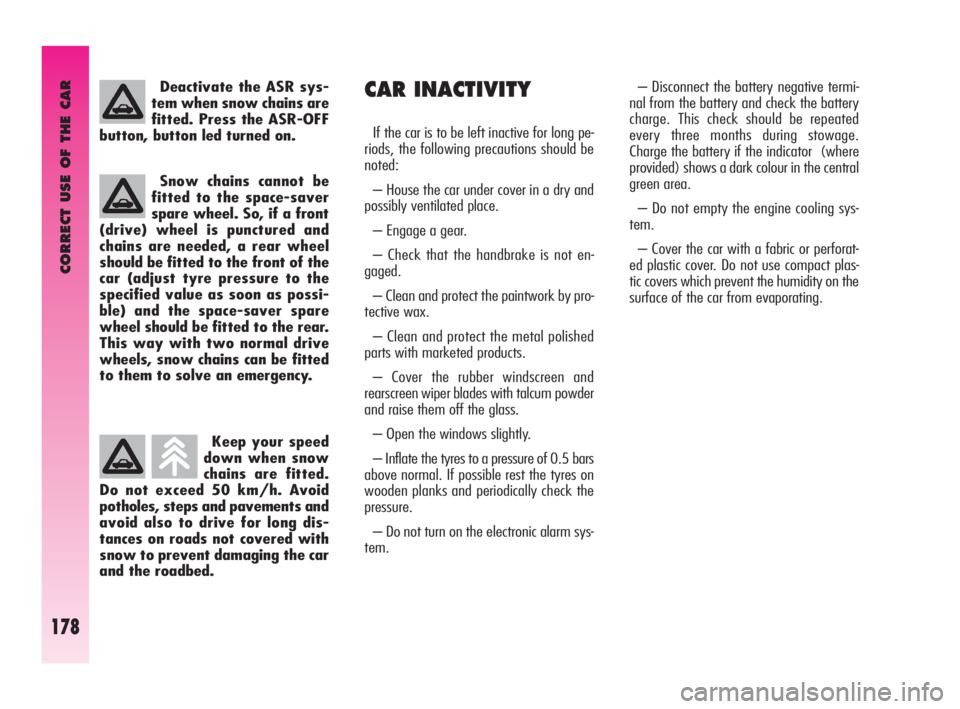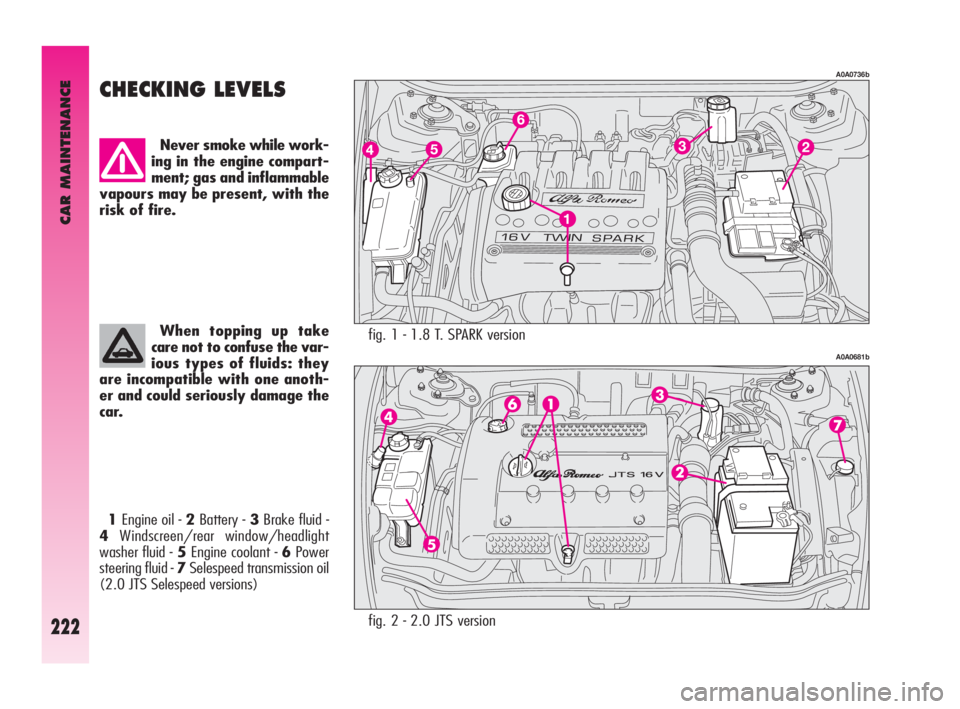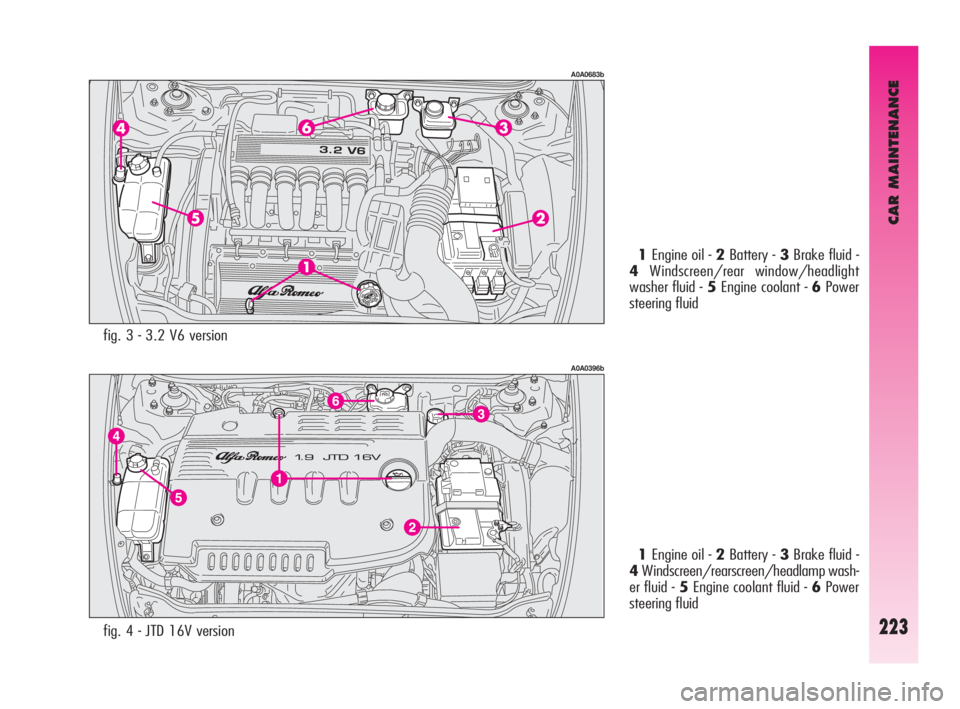window Alfa Romeo GT 2010 Owner handbook (in English)
[x] Cancel search | Manufacturer: ALFA ROMEO, Model Year: 2010, Model line: GT, Model: Alfa Romeo GT 2010Pages: 271, PDF Size: 5.34 MB
Page 106 of 271

GETTING TO KNOW YOUR CAR
104
WING MIRROR AND
REARSCREEN
DEFROSTING/DEMISTING
BUTTON
(fig. 110)
Pressing button (9)
(turns on
demisting/defrosting of the rearscreen
and, if present, the wing mirror coils.
The turning on of this function is shown
by the turning on of the led on the button.
This function is timed and switches off
automatically after 20 minutes, or press-
ing the button again; the function is also
switched off when the engine is stopped
and will not be switched on again the next
time the engine is started.
IMPORTANTThe system automatical-
ly turns on rearscreen heating if the tem-
perature is below 3°C.
IMPORTANTDo not apply stickers on
the inside of the rearscreen over the heat-
ing filaments to avoid damage that might
cause it to stop working properly.
POLLEN FILTER
Have the conditions of the filter checked
by Alfa Romeo Authorised Services at least
once a year, preferably at the onset of
summer.
If the car is used mainly in dusty or pol-
luted areas it should be checked and, if
necessary, replaced at shorter intervals.
A0A0214b
The filter has the specific capability of fil-
tering external air, thus admitting to the
passenger compartment purified air, free
from particles such as dust, pollen, etc.
In addition to the above mentioned func-
tions, is also reduces the concentration of
pollutants.
The filtering action takes place under all
air inlet conditions and it is clearly most
effective with the windows shut.If the filter is not replaced
the efficiency of the cli-
mate control system may
be seriously compromised up to
blocking the air flow at the outlets
and vents.
fig. 110
Page 180 of 271

CORRECT USE OF THE CAR
178
Keep your speed
down when snow
chains are fitted.
Do not exceed 50 km/h. Avoid
potholes, steps and pavements and
avoid also to drive for long dis-
tances on roads not covered with
snow to prevent damaging the car
and the roadbed.
CAR INACTIVITY
If the car is to be left inactive for long pe-
riods, the following precautions should be
noted:
– House the car under cover in a dry and
possibly ventilated place.
– Engage a gear.
– Check that the handbrake is not en-
gaged.
– Clean and protect the paintwork by pro-
tective wax.
– Clean and protect the metal polished
parts with marketed products.
– Cover the rubber windscreen and
rearscreen wiper blades with talcum powder
and raise them off the glass.
– Open the windows slightly.
– Inflate the tyres to a pressure of 0.5 bars
above normal. If possible rest the tyres on
wooden planks and periodically check the
pressure.
– Do not turn on the electronic alarm sys-
tem.– Disconnect the battery negative termi-
nal from the battery and check the battery
charge. This check should be repeated
every three months during stowage.
Charge the battery if the indicator (where
provided) shows a dark colour in the central
green area.
– Do not empty the engine cooling sys-
tem.
– Cover the car with a fabric or perforat-
ed plastic cover. Do not use compact plas-
tic covers which prevent the humidity on the
surface of the car from evaporating. Snow chains cannot be
fitted to the space-saver
spare wheel. So, if a front
(drive) wheel is punctured and
chains are needed, a rear wheel
should be fitted to the front of the
car (adjust tyre pressure to the
specified value as soon as possi-
ble) and the space-saver spare
wheel should be fitted to the rear.
This way with two normal drive
wheels, snow chains can be fitted
to them to solve an emergency.
Deactivate the ASR sys-
tem when snow chains are
fitted. Press the ASR-OFF
button, button led turned on.
Page 217 of 271

IN AN EMERGENCY
215
– In motorways pileups, especially with
poor visibility, the risk of being involved in
other crashes is high. Leave the car imme-
diately and go beyond the guard-rail.
– If doors are blocked, do not try to get
out of the car breaking the windscreen which
is stratified. The windows and rear screen
are easier to break.
– Remove the ignition key of the cars in-
volved.
– If you note a smell of fuel or other chem-
ical products, do not smoke and have a cig-
arette stubbed out.
– To put out fires, even small ones, use
the extinguisher, blankets, sand, or earth.
Never use water.
– If use of the lighting system is not nec-
essary, disconnect the battery negative ter-
minal (–).IN THE EVENT
OF AN ACCIDENT
– It is important to keep calm.
– If you are not directly involved, stop at
least a few dozen metres away from the ac-
cident.
– On motorways, stop without blocking
the emergency lane.
– Turn the engine off and the hazard warn-
ing lights on.
– At night, illuminate the place of the ac-
cident with the headlights.
– Take care, do not risk being run over.
– Signal the accident placing the triangle
at regulation distance in a clearly visible
place.
– Call the emergency organisation, giving
the most accurate information possible. On
motorways use the special phones provid-
ed.
IF PEOPLE ARE INJURED
– An injured person must never be aban-
doned. Helping is compulsory also for per-
sons not directly involved in the accident.
– Do not crowd around injured people.
– Reassure the injured person that help
is on the way, and stay near to overcome
any panic.
– Release or cut the seat belt restraining
injured persons.
– Do not give injured persons anything
to drink.
– An injured person should never be
moved except in the following circum-
stances.
– Remove an injured person from the car
only in danger of fire, sinking or falling.
When removing an injured person: do not
pull the limbs or bend the head and keep
the body as horizontal as possible.
FIRST AID KIT
In addition to the first-aid kit, it is also
wise to keep an extinguisher and a blan-
ket in the car.
Page 224 of 271

CAR MAINTENANCE
222
fig. 1 - 1.8 T. SPARK version
A0A0736b
A0A0681b
CHECKING LEVELS
Never smoke while work-
ing in the engine compart-
ment; gas and inflammable
vapours may be present, with the
risk of fire.
When topping up take
care not to confuse the var-
ious types of fluids: they
are incompatible with one anoth-
er and could seriously damage the
car.
fig. 2 - 2.0 JTS version 1Engine oil - 2Battery - 3Brake fluid -
4Windscreen/rear window/headlight
washer fluid - 5Engine coolant - 6Power
steering fluid - 7Selespeed transmission oil
(2.0 JTS Selespeed versions)
Page 225 of 271

CAR MAINTENANCE
223
A0A0396b
fig. 4 - JTD 16V version1Engine oil - 2Battery - 3Brake fluid -
4Windscreen/rearscreen/headlamp wash-
er fluid - 5Engine coolant fluid - 6Power
steering fluid
A0A0683b
fig. 3 - 3.2 V6 version 1Engine oil - 2Battery - 3Brake fluid -
4Windscreen/rear window/headlight
washer fluid - 5Engine coolant - 6Power
steering fluid
Page 234 of 271

CAR MAINTENANCE
232
Proceed as follows with doors closed:
1.open completely the driver’s window
keeping the button pressedfor at
least 3 seconds after full opening;
2.close completely the driver’s window
keeping the button pressedfor at
least 3 seconds after full closing;
3.proceed as described in points 1 and
2 also for the passenger’s side;
4.check for proper initialisation by oper-
ating the windows in automatic.
USEFUL HINTS TO EXTEND
THE LIFE OF YOUR BATTERY
To avoid rapidly draining the battery and
ensure that it continues to work correctly,
the following should be noted:
– The terminals must always be firmly
tightened.
– As far as possible, avoid keeping ser-
vices on for a long time with the engine
stopped (radio, hazard lights, parking lights,
etc.). IMPORTANTIf the battery is kept with
a charge of below 50% it is damaged by sul-
phation, its starting capability is reduced and
it is also more subject to the possibility of
freezing (this may occur already at -10 °C).
In the event of a prolonged inactivity, refer
to the paragraph “car inactivity”, in the
chapter “Correct use of the car”.
CHANGING
THE BATTERY
When changing the battery it should be re-
placed with another original one with the
same characteristics. If it is replaced by a
battery with different characteristics, the
maintenance intervals given in the Sched-
uled Maintenance Programme in this chap-
ter are no longer valid and for maintenance
it will be necessary to follow the battery
Manufacturer’s instructions.
IMPORTANTLacking power to control
units (e.g. battery change/disconnection
and replacement of power window control
unit protection fuses), window automatism
must be reset.– When leaving the car parked in a
garage, make sure that the doors, bonnet,
boot and interior lids are properly shut to
prevent lights from staying on.
– Before carrying out any work on the
electric system, disconnect the negative ca-
ble from the battery.
– If after buying the car, you wish to in-
stall electric accessories which require a per-
manent electric supply (alarm, voice feature,
radionavigator with satellite antitheft func-
tion etc.) or accessories that burden the elec-
tric system, contact Alfa Romeo Authorised
Services whose qualified personnel, in ad-
dition to suggesting the most suitable de-
vices belonging to Lineaccessori Alfa Romeo,
will evaluate the overall electric absorption,
checking whether the car’s electric system
is capable of withstanding the load required,
or whether it should be integrated with a
more powerful battery. In fact, as some of
these devices continue absorbing energy
even when the ignition key is off (car sta-
tionary, engine off), they gradually drain the
battery.
Page 240 of 271

CAR MAINTENANCE
238
Engine compartment
At the end of the winter the engine com-
partment should be carefully washed, with-
out directing the jet against electronic con-
trol units. Contact a specialised workshop to
have this done.
Detergents cause water
pollution. Therefore the en-
gine compartment should
be washed in areas equipped for
collecting and purifying the liquid
used in the washing process.
IMPORTANTThe car should be washed
with the engine cold and the ignition key at
STOP. After washing make sure that the
various protections (e.g. rubber caps and
various covers) have not been damaged or
removed. Windows
Use specific products to clean the windows.
Use clean cloths to avoid scratching or al-
tering the transparency of the glass.
IMPORTANTThe inside of the
rearscreen should be wiped gently with a
cloth in the direction of the filaments to
avoid damaging the heating device.
Front headlights
IMPORTANTDo not use aromatic sub-
stances (e.g. petroleum) or ketones (e.g.
acetone) to clean the front headlight plas-
tic transparents.
Never use inflammable
products like fuel oil ether
or rectified petrol for clean-
ing inside the car. The electrostat-
ic charges generated when rubbing
to clean may cause fire.
INTERIOR FITTINGS
Periodically check that water is not trapped
under the mats (due to water dripping off
shoes, umbrellas, etc.) which could cause
oxidisation on the sheet metal.
CLEANING SEATS AND FABRIC
AND VELVET PARTS
– Use a soft brush or a vacuum cleaner to
remove dust. Velvet is cleaned better if the
brush is moistened.
– Rub the seat with a sponge moistened
with a solution of water and neutral deter-
gent.
Page 256 of 271

TECHNICAL SPECIFICATIONS
254
Brake fluid
Protective agent for radiators
Windscreen and rear window
washer fluid Lubricants and greases for
transmissions Use
Fluid and lubricant specifications
for correct car operation
Synthetic-based oil, grade SAE 75W-85
that passes API GL-4 PLUS, FIAT 9.55550
Lubricant for automatic transmissions that passes
“ATF DEXRON II D LEV” specification
Specific fluid for gear selector electrohydraulic actuators
Molibdenum disulphide, lithium soap based grease.
Synthetic fluid, F.M.V.S.S. n. 116, DOT 4, ISO 4925, SAE J-1704
Protective with antifreeze action, red colour based on inhibited monoethylen
glycol and organic formula, that passes CUNA NC 956-16,
ASTM D 3306 specifications
Mixture of alcohol and surfactants CUNA NC 956-11Genuine fluids
and lubricants
TUTELA
CAR TECHNYX
TUTELA GI/A
TUTELA CAR CS SPEED
TUTELA STAR 500
TUTELA TOP 4
for Alfa Romeo
PARAFLU
UP
TUTELA
PROFESSIONAL SC 35Applications
Mechanical gearbox and
differential
Hydraulic power steering
Selespeed
electrohydraulic actuator
CV joints
on wheel side
Brake and clutch
hydraulic controls
Cooling circuits.
Proportion:
50% down to –35° C.
Not to be mixed with
products having different
formulas.
To be used diluted or
undiluted
Page 259 of 271

RIGHT HAND DRIVE VERSION
257
DASHBOARD
fig. 1
A0A0724b
1.Adjustable side air vents - 2.Fixed side window air vents -3.Front passenger’s air bag - 4.Tailgate release button - 5.Cards holder (for versions/mar-
kets where applicable) - 6. Sound system (for versions/markets where applicable) -7.Adjustable central air vents - 8.Upper fixed vent - 9.Glass/can
holder (for versions/markets where applicable) - 10.Front fog light button - 11.Hazard light switch - 12.Rear fog light button - 13.External lights con-
trol lever - 14.Instrument panel - 15.Windscreen wiper stalk - 16. Bonnet opening lever - 17.Set of controls - 18.Ignition key and ignition switch - 19.
Horn - 20.Steering wheel locking/release lever - 21.Driver’s air bag - 22.Door locking button - 23.Heating/ventilation/climate controls - 24.Cigar
lighter/ashtray housing lid - 25.Temperature sensor - 26.Glovebox.
Page 262 of 271

ALPHABETICAL INDEX
260
I I
N N
D D
E E
X X
ABS system .............................. 134
Accessories purchased by the user .. 127
Additional stop light (third stop) .... 200
Air bags ..................................... 38
Air cleaner .................................. 229
Alfa Romeo CODE ........................ 6
Armrest
- front ..................................... 17
- rear ...................................... 22
Ashtray
- front ........................................ 124
- rear ......................................... 125
ASR (system) ............................. 138
Battery
- advice for preserving
the charge ............................. 232
- checking the charge ........... 212-231
- replacement ........................... 232
Body (maintenance) ................... 236
Body versions ............................. 241 Bonnet ...................................... 131
Boot
- extension .............................. 19
- lighting ................................. 129
- luggage net ........................... 22
- opening from inside ................ 128
- opening with remotecontrol ..8-128
- restraining the load ................. 130
- tailgate closing ....................... 129
- warnings for carrying luggage ... 130
Boot light
- changing bulbs ....................... 204
Brakes ....................................... 245
Braking lights (third stop)
- changing bulbs ....................... 199
Bulbs
- general instructions ................. 193
- replacement ........................... 192
- type of bulbs .......................... 193
Card and glass holder ................. 125
Car maintenance.................... 216
Cell phones (provision) ................ 126
Changing a wheel .................. 181-183 Changing bulbs
- general instructions ................. 192
- types of bulbs ........................ 193
Checking levels ........................... 222
Cigar lighter ............................... 124
Cleaning and maintenance
- body ..................................... 236
- car interior ............................. 238
- engine compartment ............... 238
- windows ............................... 238
Climate control system ................. 81
Climate control system,
automatic two-zone .................. 89
Clock ......................................... 68
Controls ..................................... 106
CO
2emissions ............................ 256
CODE card .................................. 7
Correct use of the car........... 169
Courtesy light
- changing bulbs ....................... 203
Cruise Control ............................. 49